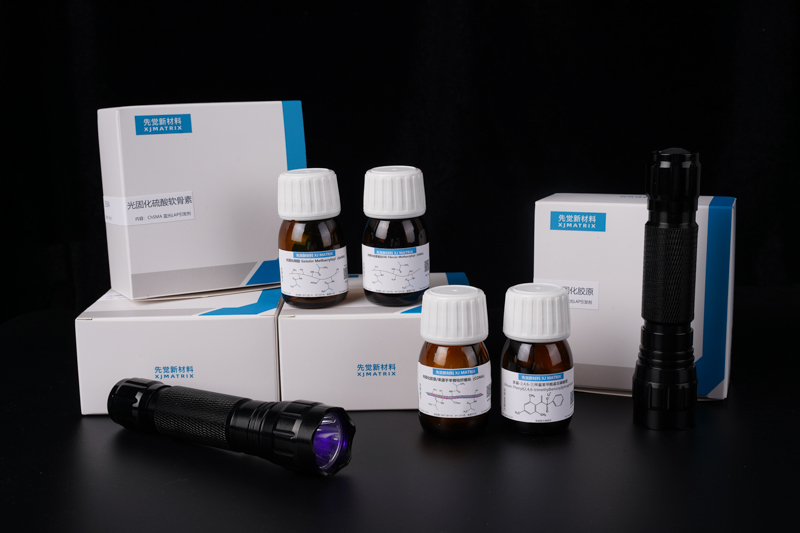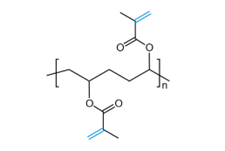| Make UP | Appearances | Specification | Storage Condition |
| PVAMA | White lyophilized sponge | 0.5 g/bottle | Warranty: 12 months at 4℃ |
| Blue light initiator LAP | White powder | 10 mg/bottle |

Polyvinyl alcohol methacryloyl (PVAMA) is a double-bond modified polyvinyl alcohol, which can be crosslinked to form a hydrogel by ultraviolet and visible light under the condition of adding photoinitiator.PVAMA hydrogel has the advantages of low toxicity, good mechanical properties (high modulus of elasticity and high mechanical strength), high water absorption, and good biocompatibility, which is widely used in biomedical fields, such as tissue engineering, 3D printing, drug carriers, and wound dressings. It is widely used in biomedical fields such as tissue engineering, 3D printing, drug carriers, wound dressings, etc.
| Make UP | Appearances | Specification | Storage Condition |
| PVAMA | White lyophilized sponge | 0.5 g/bottle | Warranty: 12 months at 4℃ |
| Blue light initiator LAP | White powder | 10 mg/bottle |
Polyvinyl alcohol methacryloyl (PVAMA) is a double-bond modified polyvinyl alcohol, which can be crosslinked to form a hydrogel by ultraviolet and visible light under the condition of adding photoinitiator.PVAMA hydrogel has the advantages of low toxicity, good mechanical properties (high modulus of elasticity and high mechanical strength), high water absorption, and good biocompatibility, which is widely used in biomedical fields, such as tissue engineering, 3D printing, drug carriers, and wound dressings. It is widely used in biomedical fields such as tissue engineering, 3D printing, drug carriers, wound dressings, etc.
Molecular Structure:

Steps for use:
1. Prepare 0.5 mg/mL initiator standard solution
Add 20 mL of solvent (sterilized water, PBS, etc.) to the brown glass bottle containing the initiator LAP, and dissolve for 30 min at room temperature, shaking several times to fully dissolve.
2. Prepare PVAMA solution (recommended concentration 5-8%)
Take appropriate amount of PVAMA into a centrifuge tube, add the prepared LAP standard solution, dissolve at 60 ℃ water bath for 4-6 h, during the period of multiple shaking, magnetic stirring dissolution faster.
Curing into gel
1. Use 405 nm blue light to irradiate the above solution containing the initiator, about 30 s can be cured into glue (irradiation time is related to the concentration of PVAMA and the blue light source, according to the required strength of the glue can be adjusted to the curing time);
2. if use 2959 initiator, need to use 365 nm UV light for irradiation and extend the irradiation time appropriately (LAP is more efficient than 2959 initiator, time is shorter), UV light will hurt the skin and eyes pay attention to protect.
2D Cell Culture
1. Dissolve the PVAMA solution containing LAP according to the above dissolution protocol and pass it through a 0.22 μm filter membrane while it is still hot;
2. Add appropriate amount of PVAMA solution into the well plate to cover the bottom surface of the plate. 3;
3. UV light curing for about 30-60s. 4;
4. Wash the cured PVAMA with PBS several times, or use culture medium for rinsing;
5. After cell counting, inoculate the cell suspension into the well plate, observe the wall attachment after 24h and carry out the subsequent cell culture.
Precautions
1. It is recommended to increase the irradiation time appropriately to obtain better curing effect. Recommended time: PVAMA concentration ≥5%, irradiation time ~30 s. 2;
2. Due to the freeze-thaw gel-forming property of PVAMA, it is prohibited to store the solution at -20℃. Therefore, please do not repeatedly freeze-thaw when using, so as not to affect the performance of the product. 3;
3. Use 2959 initiator needs higher temperature to dissolve in water or PBS (solubility in water ≥ 5 mg/mL);
4. LAP initiator solution can be stored for 12 months at 4℃ protected from light, but it is recommended to use it now;
5. It is recommended to use LAP initiator for cellular experiments because blue light irradiation is gentler to cells than UV.
6. After adding LAP, the solution needs to be protected from light and the centrifuge tube can be wrapped with tin foil;
7. Our company is only responsible for the quality control of the material itself, and is not responsible for the results of subsequent additional biological experiments and other results not related to the quality control of the material itself.
The date of production is shown in the package:
Suzhou Xianjue New Material Technology Co.
Tel: 18068408145
Address: No. 1360, Jinji Lake Avenue, Suzhou, Yue Long Business, 2nd Floor.
